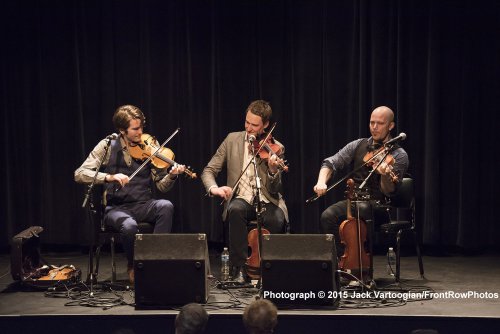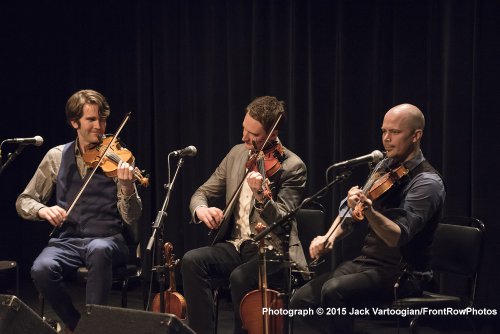Nordic Fiddlers Bloc
Fabulous folk music from Norway, Sweden and the Shetland Islands: brilliant, fun and gorgeous.
[avatar user=”Jean Ballard Terepka” size=”96″ align=”left” ] Jean Ballard Terepka, Music Critic[/avatar] In the early evening of April 22, 2015, in the inviting intimacy of the Leonard Nimoy Theater at Symphony Space, the three fine musicians of Nordic Fiddlers Bloc, represented here by the World Music Institute, played the first concert of their first U.S. tour. The three fiddlers are inspired and disciplined artists; they are also witty, charming and, in fact, quite cool performers who clearly love their music, their instruments and, most of all, the satisfying excitement of putting on a good show. Which they completely did.
The Nordic Fiddlers Bloc consists of Olav Luksengard Mjelva from Norway (hardanger and octave fiddles), Kevin Henderson from Shetland (fiddle) and Anders Hall from Sweden (fiddle and viola); the three met informally through mutual friends and colleagues and have been playing together seriously for some five years. Each artist has an extensive and stellar career apart from and in addition to Nordic Fiddlers Bloc. They live their professional lives in overlapping spheres of teaching and composing as well as collaborating, recording and performing with other artists and groups. As the competently English speaking Nordic Fiddlers Bloc, they have developed a congenial performance style that alternates humorously self-deprecating but helpfully informative banter with individual “tunes.” The evening had the feel of both formal concert and calmly funky gig.
The music was marvelous, presented in two 45 minute sets divided by a 15 minute intermission.
Each individual tune of the first half of the concert was wonderful; in addition, each one provided a particular element – a national tradition, a typical rhythm or dance pattern, a cultural borrowing, a historical pattern – of the larger contemporary Nordic folk music world. The tunes of the second half seemed to build on the first, much as though the fabulous ingredients had been assembled, examined and lingered over in the first set and then the lovely, luscious cooking really took place in the second. Interestingly, as it turns out, almost all of the first set tunes appear on the group’s first CD, Nordic Fiddler Bloc, and most of the material of the second set is what the fiddlers are working on now for their next CD.
Separately and together, Mjelva, Henderson and Hall were in masterful and unique control of the core creative paradox of contemporary folk music: preserving and curating what is centuries old, they simultaneously respond to the inspirations and anxieties of the present to produce something modern and new. The excellence of the Nordic Fiddler Bloc lies in the fact that their own individual added elements – their twenty-first century insights – don’t compromise the other-worldly timelessness of the traditional material but, instead, enrich and illuminate it. Whether performing old tunes whose history was unknown, tunes attributed to folk figures of the past, tunes written by known composers, or their own pieces, Mjelva, Henderson and Hall make the musical “vocabulary” of the old so completely their own that they can tell both the old stories and a wide variety of new ones.
For an American audience, Nordic Fiddler Bloc’s material feels both familiar and somewhat foreign. Polkas and reels have been part of American culture in various discrete waves of popularity since the colonial era; fiddling has been part of the musical landscape since Europeans first invaded the North American continent. In contemporary American folk fiddling, historical contributions have merged to make a music that sounds, to non-specialized audiences, fairly homogeneous. Performers and scholars can pick out particular musical features whose origins are in the British Isles or Scandinavia, in the former Austro-Hungarian Empire – Christian and Jewish – or in the Mediterranean world … but in general it takes an immersion in one or the other to find or hear the particular features. In this concert, two outstanding features of Nordic music were particularly clear. First, power and force are in constant play with delicacy and lyrical sweetness; second, optimism and melancholy are extremes of a continuum on which emotions are always moving and restless.
These three fiddlers are virtuosic musicians. Though the basic rhythm of many of the tunes and pieces is often quite simple – for instance, in three/four – syncopations and cross-rhythms, jumps, stops, surprises and unexpected pulses all make each piece a constant movement of percussive elements. The music is so very visual that the core rhythm – waltz or reel or polka – can be seen as the dance steps and the rhythm-plays as toes-and-heels on wooden floors, as claps and clicks, as skirt-swishings and high energy whoops and hollers. Simultaneously, the astonishing harmonies, echoes, anticipations and dialogs around core melodies create ceaselessly imaginative textures of musical sound, some as hotly intense high-stakes athletic games and others as coolly shimmery as evening light on quiet lake water.
Playing just three instruments, Mjelva, Henderson and Hall make music that sounds like it’s come from a full string orchestra. Exploring all of each instrument’s possibilities and juxtaposing “regular” violins’ and violas’ abilities with those of specialized national fiddles such as the hardanger, Nordic Fiddler Bloc creates a distinctive sound of clarity, modern edginess and evocative other-worldliness. Their playing manages the magic balance of exceptionally tight control on the one hand and relaxed, dynamic fluidity on the other.
Particular tunes were memorable.
Some dances – polkas and jigs, a competitive halling and an impertinent, sassy plattgympa – made remaining in one’s seat exceptionally difficult. For many audience members, toe-tapping and head-bobbing were irrepressible.
Two pieces were hauntingly beautiful. A traditional centuries-old whaling tune, discovered at the time of first contact with the Inuit, was half sea shanty and half lullaby, an evocation of memory, loss and an impossibly hopeful dream that waiting sweethearts will be kissed once again. Another piece – entirely modern, composed by Mjelva to celebrate Henderson’s passionate birdwatching avocation presented an elegant, intimate description of waiting and anticipation, patience and then thrill; plucked pizzicato notes – not a typical feature of Nordic fiddling – marked birds’ flitting and teasing while long bowings evoked the birder’s integration of self into landscape. The birdwatching song was a lovely testament to the personal and musical friendships that clearly bind these three men together.
One of the longest pieces, from the second set, was also one of the most dramatic of the whole evening. An eighteenth century polska tune after legendary soldier-fiddler Flinka Johanni told the story of a Swedish soldier, weary from the endless wars of the era, managing almost alone of all his comrades to survive the freezing mountain-top winter blizzards and come back home. Arranged primarily by Hall, though clearly, like all their material, the product of extensive three-way collaboration, this work was explicitly narrative in feel; the sound was huge and sweeping, an unexpected descendant of nineteenth century symphonic Romanticism, and poignant, evocative of both loss and gratitude.
Some of Nordic Fiddler Bloc’s material comes from earlier fiddler-composers such as Peter Fraser and Sven Nyhus, but both Mjelva and Henderson both compose. The second set opened with a piece by Henderson, composed when he was teaching at the Boston Harbor Scottish Fiddle School; here, the traditional musical language was both enriched and challenged by jazz and rock’n’roll allusions, both explicit and oblique.
In the richness of its traditions, Nordic Fiddler Bloc’s music can be the subject of both scholarly analysis and critical examination, but one important element must not be overlooked.
The central experience of the Nordic Fiddler Bloc concert is an experience of happy, vibrant music-making. Some of the tunes are plain, flat-out fun. Some are just so gorgeous that you wish they wouldn’t end. This is music about dancing together and making community; it is music about how people share each other’s lives. Rooted very far in the past, it’s nonetheless music about optimism and the future. At the end of the concert, you’re delighted at the prospect of whatever might come next. What could be better?
Nordic Fiddlers Bloc (April 22, 2015)
World Music Institute
Leonard Nimoy Thalia Theatre at Symphony Space
2537 Broadway at 95th Street, in Manhattan
For more information: visit http://www.symphonyspace.org, http://www.worldmusicinstitute.org or http://www.thenordicfiddlersbloc.com
Running time: 110 minutes








Leave a comment